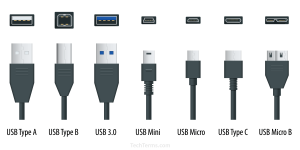That is a charger with USB-C ports and you would use cord with C type on each end I would presume.
My wife and I each have low-end iPad devices that have Apple Lightning charge ports. The 2020 version has C to C cable and a C charger. The 2017 (I think) came with a USB-A port and A-Lightning cable.
What I don't know is whether the C type has different power and/or data transferring ability than the micro USB type has.
What a can of worms. Depending on the power ratings, a C power source offers a variety of voltages. A device needing only 5V can plug into any of them.
If it is <=15W, it is 5V only
If it is 15W-27W, it adds 9V
If it is 27W-45W, it adds 15V
If it is 45W-100W, it adds 20V
see
https://en.wikipedia.org/wiki/USB_hardware#USB_Power_Delivery for more info
The CONNECTOR supports as of now up to 40 Gbps. Few cables do.
If you had USB-C charger and plugged in with a cable that had micro on other end you maybe don't get any benefits that the C type might have over the micro type?
I believe, but don't know, that some Android devices use a micro and 9V. I know that USB-C to Lightning supplies 9V to more modern iPhones and iPads. Apple furnishes 18W or 20W wall warts. SOMEHOW there has to be communication to the source.
I also have a MacBook Air which is USB-C as a charge port. Apple furnishes a 30W wall wart with it. I suspect it used 15V to charge. I have an aftermarket charger from Anker which is rated 45W; it charges any of my devices with USB-C or lightning ports. I don't know if it gets to the 20V level, nor do I know how to measure it. The smart load must be connected. I would not mind stripping a basic (I think 400 kbps max) to see, but haven't.



